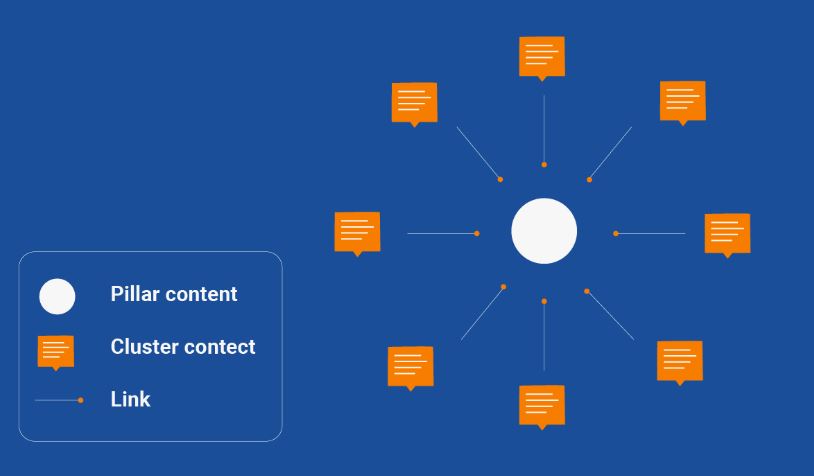In the ever-evolving world of digital marketing, search engine optimization (SEO) remains a critical focus for businesses looking to enhance their online visibility. One effective strategy that has gained traction in recent years is content clustering. This approach not only helps improve SEO but also enhances user experience by organizing content in a logical and accessible manner. In this blog, we will explore what content clustering is, how it works, and practical strategies to implement it effectively.
What is Content Clustering?
Content clustering is a sophisticated SEO strategy designed to enhance your website’s organization and improve its search engine visibility. This approach involves creating a cohesive group of related content pieces centered around a primary topic, known as a pillar page. The pillar page acts as the central hub for this topic, providing a comprehensive overview and serving as a gateway to more specific, detailed content—referred to as cluster content—that delves into various subtopics related to the main theme.
How Content Clustering Works
The structure of content clustering is akin to a tree, where the pillar page represents the trunk and the cluster content represents the branches. This hierarchical organization not only helps search engines understand the relationship between different pieces of content but also enhances the user experience by making it easier for visitors to navigate through related information.
Pillar Page
This is an extensive, authoritative piece that covers a broad topic in depth. It should provide valuable insights, key concepts, and an overview of the subject matter. The pillar page typically includes:
- Internal Links: These direct readers to related cluster content, encouraging deeper exploration of the topic.
- SEO Optimization: It is optimized for primary keywords relevant to the main topic.
Cluster Content
These are individual articles or blog posts that focus on specific aspects of the broader topic introduced in the pillar page. Each piece of cluster content should:
- Address Specific Questions: Provide detailed answers or insights into particular subtopics.
- Link Back to the Pillar Page: Reinforce the connection between the content pieces and guide readers back to the main hub.
Identify Core Topics
Start by identifying the main topics relevant to your audience and industry. These topics should align with your business goals and target keywords.
- Keyword Research: Use tools like Google Keyword Planner or SEMrush to find high-volume keywords.
- Competitor Analysis: Analyze competitors’ content to identify gaps and opportunities.
- Audience Insights: Gather feedback from your audience through surveys or social media engagement.
Also Read:
- Digital Marketing Tools for Small Businesses
- Digital Marketing Funnel Stages and Tactics for Conversions
- Why Blogs Are Important for SEO
Benefits of Content Clustering
Implementing a content clustering strategy offers several key benefits:
- Enhanced SEO Performance: By organizing content around a central theme, search engines can better understand your site’s structure and relevance, leading to improved rankings.
- Improved User Engagement: A well-organized content structure allows users to easily find related information, increasing their time on site and reducing bounce rates.
- Establishment of Authority: By covering a topic comprehensively, you position your brand as an authority in your niche, building trust with your audience.
Example of Content Clustering
| Pillar Page | Cluster Content |
| Digital Marketing Strategies | SEO Techniques |
| Social Media Marketing | |
| Email Marketing Best Practices | |
| Content Marketing Fundamentals |
Best Practices for Content Clustering
To maximize the effectiveness of your content clustering strategy, consider the following best practices:
Maintain Consistency
Ensure that all content within a cluster maintains a consistent tone and style. This helps reinforce your brand identity and improves the user experience.
Regularly Update Content
Keep both pillar pages and cluster content fresh by regularly updating them with new information, statistics, or insights.
Monitor Performance Metrics
Use analytics tools like Google Analytics to track the performance of your pillar pages and cluster content. Key metrics to monitor include:
| Metric | Description |
| Organic Traffic | The number of visitors coming from search engines. |
| Bounce Rate | The percentage of visitors who leave after viewing one page. |
| Time on Page | The average time users spend on each page. |
| Conversion Rate | The percentage of visitors who complete a desired action (e.g., signing up for a newsletter). |
Common Challenges in Content Clustering
While content clustering offers many benefits, there are challenges to be aware of:
Time-Consuming Process
Creating comprehensive pillar pages and detailed cluster content can be time-intensive.
Requires Ongoing Maintenance
Regular updates and monitoring are necessary to keep content relevant and effective.
Potential Overlap in Topics
Careful planning is required to ensure that cluster content does not overlap excessively with other clusters.
Conclusion
Content clustering is a powerful strategy for improving SEO and enhancing user experience on your website. By organizing your content around core topics and creating comprehensive pillar pages linked to detailed cluster articles, you can boost your site’s authority and visibility in search engine results.
As you implement this strategy, remember the importance of consistency, regular updates, and performance monitoring. By continually refining your approach based on data-driven insights, you can ensure that your content remains relevant and valuable to your audience.
In today’s competitive digital landscape, leveraging content clustering can set you apart from competitors while driving organic traffic and conversions. Embrace this strategy as part of your overall SEO efforts, and watch as it transforms your online presence into a resource that attracts and engages users effectively. If you’re looking for expert guidance in implementing content clustering, consider partnering with a digital marketing agency like Moobila.



